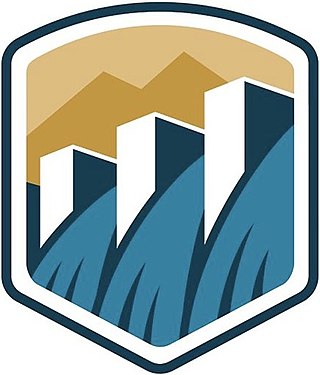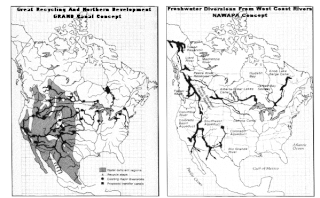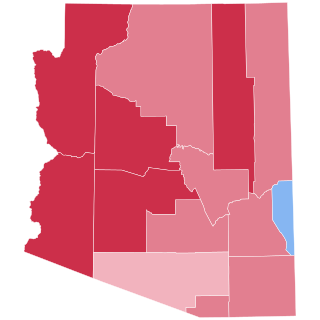An oasis is an isolated area of vegetation in a desert.

The Bureau of Reclamation, formerly the United States Reclamation Service, is a federal agency under the U.S. Department of the Interior, which oversees water resource management, specifically as it applies to the oversight and operation of the diversion, delivery, and storage projects that it has built throughout the western United States for irrigation, water supply, and attendant hydroelectric power generation. It is currently the U.S.'s largest wholesaler of water, bringing water to more than 31 million people, and providing one in five Western farmers with irrigation water for 10 million acres of farmland, which produce 60% of the nation's vegetables and 25% of its fruits and nuts. The Bureau is also the second largest producer of hydroelectric power in the western U.S.

The Teton Dam was an earthen dam in the western United States, on the Teton River in eastern Idaho. It was built by the U.S. Bureau of Reclamation, one of eight federal agencies authorized to construct dams. Located between Fremont and Madison counties, it suffered a catastrophic failure on June 5, 1976, as it was filling for the first time.

Cadillac Desert: The American West and Its Disappearing Water is a 1986 American history book by Marc Reisner about land development and water policy in the western United States. The book largely focuses on the history of two federal agencies, the Bureau of Reclamation and the U.S. Army Corps of Engineers, and their struggles to remake the American West in ways to satisfy national settlement and energy generation goals. The book concludes that the development-driven policies, formed when settling the West was the country's main concern, have had serious long-term negative effects on the environment and water quantity.

Floyd Elgin Dominy was appointed commissioner of the United States Bureau of Reclamation from May 1, 1959, to December 1, 1969, by Dwight D. Eisenhower. Dominy joined the Bureau in 1946. He was the assistant commissioner from 1957 to 1958. He was responsible for building Glen Canyon Dam and the creation of Lake Powell behind it. He died in Boyce, Virginia, where he had lived since at least 1990.
Marc Reisner was an American environmentalist and writer best known for his book Cadillac Desert, a history of water management in the American West.

The Red Queen's race is an incident that appears in Lewis Carroll's Through the Looking-Glass and involves both the Red Queen, a representation of a Queen in chess, and Alice constantly running but remaining in the same spot.
"Well, in our country," said Alice, still panting a little, "you'd generally get to somewhere else—if you run very fast for a long time, as we've been doing."
"A slow sort of country!" said the Queen. "Now, here, you see, it takes all the running you can do, to keep in the same place. If you want to get somewhere else, you must run at least twice as fast as that!"

Rain follows the plow is the conventional name for a now-discredited theory of climatology that was popular throughout the American West and Australia during the late 19th century. The phrase was employed as a summation of the theory by Charles Dana Wilber:
God speed the plow. ... By this wonderful provision, which is only man's mastery over nature, the clouds are dispensing copious rains ... [the plow] is the instrument which separates civilization from savagery; and converts a desert into a farm or garden. ... To be more concise, Rain follows the plow.

Inyo National Forest is a United States National Forest covering parts of the eastern Sierra Nevada of California and the White Mountains of California and Nevada. The forest hosts several superlatives, including Mount Whitney, the highest point in the contiguous United States; Boundary Peak, the highest point in Nevada; and the Ancient Bristlecone Pine Forest, which protects the oldest living trees in the world. The forest, encompassing much of the Owens Valley, was established by Theodore Roosevelt as a way of sectioning off land to accommodate the Los Angeles Aqueduct project in 1907, making the Inyo National Forest one of the least wooded forests in the U.S. National Forest system.

A nature documentary or wildlife documentary is a genre of documentary film or series about animals, plants, or other non-human living creatures. Nature documentaries usually concentrate on video taken in the subject's natural habitat, but often including footage of trained and captive animals, too. Sometimes they are about wildlife or ecosystems in relationship to human beings. Such programmes are most frequently made for television, particularly for public broadcasting channels, but some are also made for the cinema. The proliferation of this genre occurred almost simultaneously alongside the production of similar television series which is distributed across the world.

Jessica Yu is an American film director, writer, producer, and editor. She has directed documentary films, dramatic films, and television shows.

Ah Pah Dam was a proposed dam on the Klamath River in the U.S. state of California proposed by the United States Bureau of Reclamation as part of its United Western Investigation study in 1951. It was to have been 813 feet (248 m) high and was to be located 12 miles (19 km) upstream of the river's mouth. It would have been taller than any existing dam in the United States and it would stand almost as tall as the Transamerica Pyramid building in San Francisco, but would have been much more massive. It would have flooded 40 miles (64 km) of the Trinity River, including the Yurok, Karuk and Hupa Indian Reservations, the lower Salmon River, and 70 miles (110 km) of the Klamath River, creating a reservoir with a volume of 15,000,000 acre-feet (19 km3) – three fifths the size of Lake Mead, and over three times the size of the current largest reservoir in California, Shasta Lake. The water would flow by gravity through a tunnel 60 miles (97 km) long to the Sacramento River just above Redding and onward to Southern California, in an extreme diversion plan known as the Klamath Diversion. The tunnel would have been located near the southernmost extent of the reservoir. It was named in the language of the Yurok people.

The 1980 United States presidential election in California took place on November 4, 1980, as part of the 1980 United States presidential election. State voters chose 45 representatives, or electors, to the Electoral College, who voted for president and vice president.

The North American Water and Power Alliance was a proposed continental water management scheme conceived in the 1950s by the US Army Corps of Engineers. The planners envisioned diverting water from some rivers in Alaska south through Canada via the Rocky Mountain Trench and other routes to the US and would involve 369 separate construction projects. The water would enter the US in northern Montana. There it would be diverted to the headwaters of rivers such as the Colorado River and the Yellowstone River. Implementation of NAWAPA has not been seriously considered since the 1970s, due to the array of environmental, economic and diplomatic issues raised by the proposal. Western historian William deBuys wrote that "NAWAPA died a victim of its own grandiosity."

The West, sometimes marketed as Ken Burns Presents: The West, is a 1996 television documentary miniseries about the American Old West. It was directed by Stephen Ives and featured Ken Burns as executive producer. It was first broadcast on PBS on eight consecutive nights from September 15 to 22, 1996.
The Western Waters Digital Library (WWDL) provides free public access to digital collections of significant primary and secondary resources on water in the western United States. These collections have been made available by research libraries other academic and institutional partners.

The 1980 United States presidential election in Utah took place on November 4, 1980. All 50 states and the District of Columbia were part of the election. State voters chose four electors to the Electoral College, which selected the president and vice president of the United States.

The 1980 United States presidential election in Arizona took place on November 4, 1980. All fifty states and The District of Columbia were part of the 1980 United States presidential election. State voters chose six electors to the Electoral College, who voted for president and vice president.

The 1980 United States presidential election in Nevada took place on November 4, 1980. All 50 states and The District of Columbia were part of the 1980 United States presidential election. State voters chose three electors to the Electoral College, who voted for president and vice president.

The 1976 United States presidential election in Arizona was part of the 1976 United States presidential election, which took place on November 2, 1976, throughout all fifty states and D.C. Voters chose six representatives, or electors to the Electoral College, who voted for president and vice president.

















